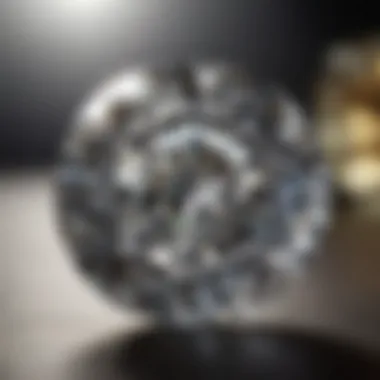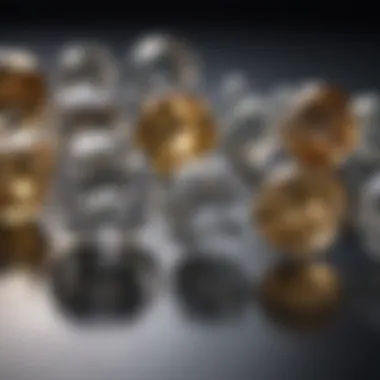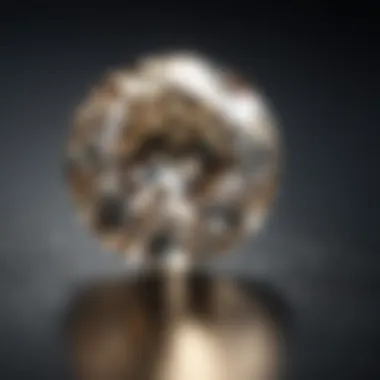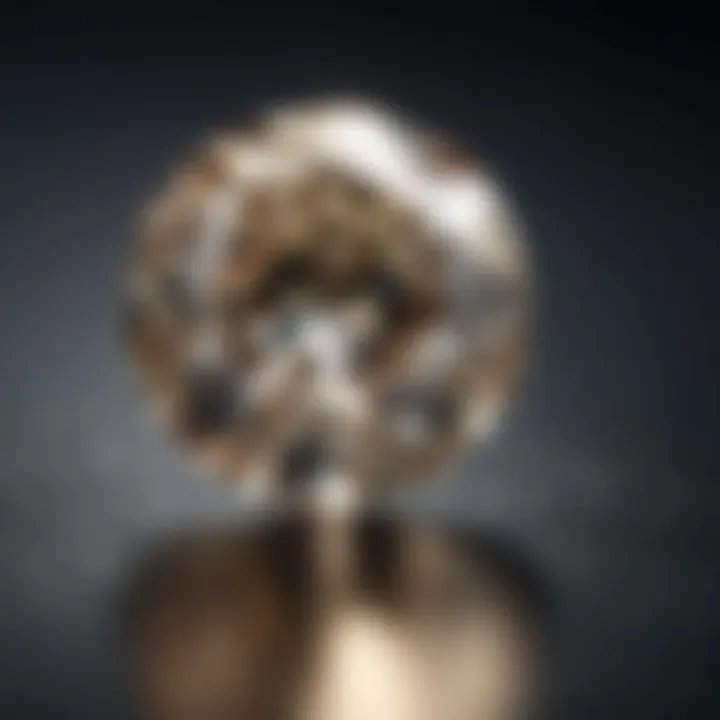Moissanite in Arizona: Exploring Its Unique Features


Intro
When one thinks of precious gemstones, diamonds usually spring to mind, yet moissanite has been making significant waves, especially in places like Arizona. With its unique charm and notable brilliance, moissanite offers a compelling alternative that sparks the interest of jewelers and collectors alike. In Arizona, a state steeped in rich geological history, the story surrounding moissanite extends beyond its aesthetic allure. A fascinating combination of scientific exploration and natural beauty reveals much about the origins and qualities of this striking gem.
This article delves deep into the essence of moissanite, tracing its journey from geological foundations in Arizona to its role in the jewelry market and beyond. From understanding its distinct characteristics to the ethical implications of its sourcing, we aim to paint a vivid picture of what makes moissanite a subject of intrigue, especially within the context of Arizona's gorgeous landscapes.
Gemstone Overview
Definition and characteristics
Moissanite, a naturally occurring silicon carbide, was originally discovered in 1893 by French chemist Henri Moissan in a meteorite. Its sparkle often rivals that of a diamond, as it possesses a remarkably high refractive index, which gives it that incredible shine. Unlike diamonds, however, moissanite displays a unique brilliance characterized by its fiery play of colors. Under certain lighting conditions, this brilliance can manifest hues that dance in the light—something that separates it from other stones on the market.
Key characteristics of moissanite include:
- Hardness: With a score of 9.25 on the Mohs hardness scale, moissanite is one of the hardest gemstones available, making it ideal for jewelry.
- Thermal Conductivity: This gem stands out with its high thermal conductivity, often used as a measurement to discern moissanite from diamonds.
- Clarity: Generally, moissanite exhibits excellent clarity, with impurities being very uncommon or insignificant.
Classification of gemstones
Gemstones can be classified based on various factors including composition, crystal structure, and provenance. Moissanite, while often classified among synthetic or lab-created stones due to its widespread production today, originally emerges from a natural context, which is worth noting.
The classification of gemstones can include:
- Natural: Gems that exist in nature, such as emeralds and sapphires.
- Synthetic: Gems that are artificially created but have the same properties as natural stones, like moissanite.
- Organic: Stones derived from biological processes, such as pearls and coral.
Moissanite often straddles the line between natural and synthetic, pushing traditional definitions and prompting discussions about value and authenticity.
Properties of Gemstones
Physical properties
Beyond the aesthetic, the physical properties of moissanite inform much about its appeal to both jewelers and customers. Its hardness, durability, and light performance make it an exceptional choice. Moissanite's ability to withstand daily wear without significant scratching or damage puts it at an advantage compared to softer gems.
Notable physical attributes include:
- Color: While colorless moissanite is most popular, it can also be found in shades of green, yellow, and brown—adding variety for collectors.
- Luster: Moissanite's brilliance adds to its luster, giving it a captivating shine that rivals other gems.
Chemical properties
The composition of moissanite provides valuable insight into its formation and behavior. Consisting largely of silicon and carbon, its chemical formula is represented as SiC. The structure of silicon carbide is noteworthy as it incorporates strong covalent bonds, leading to exceptional thermal stability and robustness.
These properties affirm why moissanite is becoming increasingly popular not only for jewelry but also in industrial applications where hardness and thermal resistance are key factors—demonstrating its versatility beyond the realm of adornment.
"The brilliance of moissanite captures the essence of light's dance, leaving a trail of stunning reflection with every glance."
In exploring moissanite within the unique geological framework of Arizona, one can appreciate the multifaceted nature of this gemstone. The journey is not just about aesthetics; it intertwines with scientific exploration, ethical sourcing, and the sustainable practices needed for the ongoing gaol of modern gemology.
Prelims to Moissanite
Moissanite has increasingly become a gem of choice in modern jewelry, overshadowing some traditional favorites due to its exceptional properties and ethical sourcing. In this article, we delve into the essence of moissanite—examining its history, characteristics, and the surrounding context. This exploration serves to highlight the significance of moissanite, particularly in Arizona, a region known for its unique geological features.
The importance of introducing moissanite is multifold. First, it sets the stage for understanding why this gem stands out not just as a visual marvel but also as an ethical choice for consumers mindful of their impact on the environment and local communities. Further, it allows for the distinction between moissanite and more conventional gemstones, thus helping buyers make informed decisions—all while being aware of the market dynamics.
Furthermore, moissanite's rise is noteworthy as it parallels a trend toward sustainability in the jewelry industry. With the jewelry market being buffeted by issues such as conflict diamonds and unethical mining, moissanite provides a fascinating alternative that combines beauty, durability, and guilt-free luxury.
What is Moissanite?
Moissanite, scientifically known as silicon carbide, is a gemstone that exceptionally resembles a diamond but possesses distinctive qualities that set it apart. Originally discovered in its natural form in a meteorite, this gem has gained fame not just for its looks, but also for its remarkable hardness, rated at 9.25 on the Mohs scale. This makes it nearly as durable as diamonds, making it a suitable candidate for engagement rings and other fine jewelry.
Visually, moissanite is striking due to its high refractive index—higher than that of diamonds—resulting in a light dispersion that creates a fiery brilliance. It catches the light in a manner that dazzles the eye, which can lead some to mistake it for diamonds unless closely inspected.
In recent years, the gemstone has transitioned largely from a naturally occurring rarity to a lab-created marvel; this process has made moissanite much more accessible to a wider range of consumers.
The Discovery of Moissanite


The story of moissanite's discovery is one for the books. The gem was first uncovered in 1893 by the French chemist Henri Moissan while he was examining a meteorite in Arizona. What makes this discovery particularly conjectural is that he did not find it as a mineral readily found in Earth’s crust, but rather as a product of extraterrestrial origin. Moissan was initially so taken by its resemblance to diamonds that he thought he had found a newly discovered form of the precious stone.
However, it wasn’t until Moissan's work was further studied that the unique properties of this gem were established. After completing his research, he realized that he had stumbled upon something entirely different and extraordinary. Thus, the connection between Arizona’s geology and moissanite has roots that dig deep, linking the state’s unique mineral compositions to the cultural fabric of gem collectors and jewelry enthusiasts alike.
Today, moissanite represents more than a brilliant gemstone; it reflects the intersection of geological exploration and human creativity. Its discovery has given rise to a thriving market, and in the context of Arizona, the story of moissanite continues to evolve alongside the ongoing appreciation for its beauty and versatility.
"Moissanite is not just a gem; it’s a testament to the wonders of nature’s bounty and human innovation."
With this groundwork laid, we are now ready to explore the geological context of Arizona that makes it a significant player in the realm of moissanite.
Geological Context of Arizona
Understanding the geological context of Arizona is crucial for comprehending the formation of moissanite as well as its unique attributes. The state is a treasure trove of geological wonders, largely shaped by volcanic activity and tectonic movements over millions of years. These geological underpinnings not only determine how gemstones form but also establish the conditions under which they can be found. In the case of moissanite, the geological landscape of Arizona offers insights into the mineral's characteristics, origins, and, ultimately, its value in both market trends and jewelry design.
Arizona's diverse geology creates an environment ripe for gem formation, making the area a significant source of various gemstones, including moissanite. The presence of certain rock types and mineral deposits plays a vital role in the development of valuable gems, suggesting that studying this region’s geological features is not only interesting but imperative for gemstone aficionados and professionals alike.
Arizona's Unique Geological Features
The state of Arizona is home to some distinctive geological features that set it apart from other regions. The mountain ranges, plateaus, and valleys contribute to the rich tapestry of minerals found underground.
Some specifics include:
- Volcanic Formations: Arizona's past volcanic activity has left behind a variety of mineral deposits. Certain ancient volcanoes, which once vented molten rock, have cooled into significant sources of diamonds, garnets, and specifically moissanite.
- Sedimentary Basins: The state is characterized by intricate sedimentary formations that create a habitat for various minerals. These basins, often layered with rich sediments, may also harbor traces of moissanite, adding to its rarer nature.
- Intrusions of Igneous Rock: Areas where molten rock has intruded into existing rock layers can lead to the crystallization of rare minerals. This fusion of elements can contribute to the formation of the unique structure of moissanite, setting it apart from other gemstones.
From the majestic Grand Canyon to the volcanic fields near Flagstaff, these features not only form the landscape but also dictate where certain gemstones can be found, including moissanite. The endless variations of minerals produced through geological processes are not just fascinating but are also foundational to the state's identity in the gemological world.
The Role of Geology in Gemstone Formation
Geology matters significantly when it comes to the formation of gemstones. The intricate relationship between the earth’s processes and the valuable minerals concealed within showcases how gems are born.
- Temperature and Pressure: For moissanite to form, it requires specific conditions of high pressure and temperatures, usually found deep within the Earth’s crust or as a result of volcanic activity. This is where the volcanic history of Arizona plays a major role.
- Mineral Composition: The availability of certain chemical elements in the rock can influence the forming process. For instance, the silicon present in volcanic rock is a primary component of moissanite formula, leading to its formation in environments rich with such minerals.
- Time: The lengthy geological processes contribute to the gem quality. Rushing this cycle could yield less desirable results, while the right conditions over time yield high-quality moissanite that is both beautiful and durable.
- Erosion and Exposure: Geological processes don’t stop at formation. Erosion can expose the moissanite hidden within layers of rocks, making it accessible for collection and study.
"The hidden treasures of the Earth are revealed through the slow dance of geological processes that shape our natural world."
In summary, the geological context of Arizona serves as the cradle for moissanite, underscoring the significance of place in gem formation. Recognizing the geological features helps gem enthusiasts appreciate the rarity and beauty of moissanite as a product of not just nature but of time itself.
Properties of Moissanite
The properties of moissanite represent a crucial aspect of understanding not just the gemstone itself, but also its implications in jewelry, culture, and economic aspects, especially in a unique geological setting like Arizona. These properties serve to differentiate moissanite from other stones, particularly diamonds, making it an appealing choice for both consumers and designers. A deeper exploration of its physical and chemical attributes elucidates the benefits, considerations, and overall appeal of incorporating moissanite into various applications, from elegant jewelry to potential market disruptor.
Physical Characteristics
Hardness and Durability
Moissanite boasts an impressive hardness rating of 9.25 on the Mohs scale, which places it just below diamond. This aspect of hardness significantly contributes to its durability, making it a practical choice for daily wear, especially in engagement rings and other frequently worn jewelry. Its robustness means that it withstands scratches and everyday wear better than many other gemstones, allowing it to retain its brilliance and clarity over time.
The key characteristic of its hardness deals with the sheer tenacity of the crystal structure. Unlike softer stones, moissanite is much less likely to chip or become damaged, giving wearers peace of mind. Additionally, its higher durability is beneficial for the busy lifestyle of many users, as they can wear it without constant worry about potential damage.
However, a unique feature arises when one considers the weight of moissanite, which is lighter than diamonds. At times, this translates to a different setting requirement or specific mounting considerations in jewelry design.
Light Dispersion
Light dispersion is another notable characteristic of moissanite. The way it refracts light is nearly remarkable, leading to a brilliance that many find superior to diamonds. It's this incredible dispersion – because of its high refractive index – that gives moissanite its signature sparkle. When light passes through, it creates a rainbow effect that can catch the eye and hold its glittering allure.
The key characteristic here revolves around its ability to reflect and refract light in ways that are visually stunning, making it a preferred choice for many jewelry enthusiasts. A distinct trait of moissanite is how its brilliance can sometimes be too pronounced for traditional tastes, leading to varied opinions on its aesthetic qualities.
"The captivating sparkle of moissanite can outshine even the most radiant diamonds, offering a different but equally luxurious perspective."
However, there lies a downside: this intense sparkle can be seen as excessive by some, affecting personalized preferences in jewelry design and aesthetics.
Chemical Properties
Comparison with Diamonds


When discussing moissanite, it’s impossible to ignore comparisons with diamonds, which are often viewed as the gold standard in gemstones. Chemically, moissanite is silicon carbide, while diamonds are pure carbon. This difference plays a vital role in everyday conversations about the gemstone. The key characteristic is the price point; moissanite, being significantly more affordable, makes a bold statement for those looking for quality without the hefty price tag.
Moreover, unique feature of moissanite is that it can sometimes exhibit color that differs from the brilliantly clear diamond; some moissanite stones present a subtle hint of color, which can turn out to be quite attractive and bring in an entirely new aesthetic to jewelry pieces. While some perceive the presence of color as a drawback, others appreciate its uniqueness. On the whole, the comparison with diamonds emphasizes the fiscal viability of moissanite in the market.
Synthetic Versus Natural Moissanite
Most moissanite available today is created in laboratories, which offers both sustainable advantages and consistency in quality control. Understanding the distinction between synthetic and natural moissanite is key. The key characteristic of synthetic moissanite is that it typically appears more flawless than natural stones due to the controlled environment in which it is created. Jewelry designers appreciate this consistency in size, shape, and quality, which is advantageous in crafting intricate designs.
The unique feature within this discussion is the growing consumer preference for lab-created stones due to ethical considerations concerning mining practices that are often associated with naturally sourced gemstones. However, a viewpoint does exist positing that natural stones, even if scarce, bring a certain charm and story that resonate with collectors and enthusiasts.
In summary, the properties of moissanite offer a fascinating intersection of durability, beauty, and ethical considerations, appealing to diverse buyers. The gemstone’s combination of physical and chemical characteristics not only elevates its status in the market but also catches the eye of gem enthusiasts, jewelry designers, and eco-conscious consumers alike.
Ethical Sourcing of Moissanite
In recent years, ethical sourcing has gained traction in the gemstone industry, and moissanite is no exception. As consumers become more mindful of the origins of their purchases, the attention shifts towards understanding how these stunning stones are obtained. Moissanite, known for its brilliance and durability, has the potential to positively impact the gemstone market when sourced and produced responsibly.
Understanding Ethical Gemstone Practices
Ethical gemstone practices encompass a range of considerations that ensure gems are mined, manufactured, and distributed in ways that respect human rights, the environment, and local communities. This includes avoiding conflict minerals and supporting fair labor practices.
In the context of moissanite, there are several aspects to address:
- Origin Transparency: Knowing where moissanite comes from is crucial. Several companies are now focusing on lab-created moissanite, which eliminates many ethical concerns associated with traditional mining.
- Environmental Impact: Mining can lead to significant environmental degradation. Lab-grown stones, however, minimize this impact, offering a sustainable alternative.
- Community Investment: Companies that prioritize ethical sourcing often reinvest in the communities from which they source their materials, improving local livelihoods.
In Arizona, where moissanite’s geological similarities with diamonds may tempt unethical practices, understanding and promoting strong ethical guidelines is even more important.
The Impact of Moissanite on the Gemstone Market
The rise of moissanite in the jewelry industry, especially in Arizona, has ripple effects on the broader gemstone market. As more consumers turn to this beautiful alternative, several impacts can be observed:
- Price Accessibility: Moissanite generally comes at a fraction of the cost of diamonds, making it an appealing option for those seeking elegant jewelry without breaking the bank.
- Market Shift: The increasing popularity of moissanite has forced traditional gemstone markets to rethink their offerings. This can lead to a more competitive landscape where quality and ethics become deciding factors for consumers.
- Sustainability trends: The growth of ethically sourced moissanite aligns well with an ongoing trend towards sustainability in the consumer market. More buyers are looking for gems that not only shine but also can be bought with a clear conscience.
"Ethical sourcing is not just a trend—it's a fundamental shift in how we view the ownership and value of gemstones."
In summary, ethical sourcing of moissanite goes beyond just purchasing choices; it reflects a larger movement towards responsible consumerism in the gemstone industry. The continuous rise of moissanite, particularly in Arizona, may serve to shift market dynamics towards practices that are not only profitable but also principled.
Moissanite in the Jewelry Industry
The jewelry industry has seen a profound shift over the years with the rising popularity of alternative gemstones, with moissanite taking center stage. In an age where consumers are more conscientious about their purchases, moissanite carves out a significant niche as a dazzling yet ethical choice. It offers a unique blend of charm and desirability.
Popularity and Trends in Arizona
Within the realm of gemstones, moissanite is enjoying a meteoric rise in Arizona. This state, known for its breathtaking landscapes and rich geological treasures, has become a hotspot for moissanite sales.
Factors fueling this trend include:
- Affordability: Moissanite provides an economical alternative to traditional diamonds. With a similar visual appearance at a fraction of the cost, many Arizonians are opting for moissanite rings and necklaces.
- Social consciousness: As awareness about ethical sourcing and environmental impact grows, consumers are more inclined toward moissanite. Unlike some mined stones, moissanite is lab-created, leading to less environmental disruption.
- Versatility: It caters perfectly to diverse tastes, whether for a whimsical design or a refined traditional piece. This adaptability resonates well with the modern consumer.
Moissanite Jewelry Options
When venturing into the realm of moissanite jewelry, the variety available is astounding. Distinct options can address individual preferences and purposes.
Engagement Rings
Engagement rings featuring moissanite have become a staple in many modern proposals across Arizona. Their alluring sparkle rivals diamonds, making them a striking choice. One of the key characteristics of moissanite engagement rings is their brilliance. Moissanite’s high refractive index ensures that any design radiates an impressive amount of light, sparking awe during proposals.
A unique feature of engagement rings crafted from moissanite is the range of customizability. Couples have the opportunity to select shapes, sizes, and settings that speak to their personal style, often leading to truly one-of-a-kind pieces. It’s not just the look that draws people in; the affordability of moissanite means couples can invest in more elaborate designs without breaking the bank.
"With moissanite, you get the best of both worlds: stunning beauty without the hefty price tag."
Custom Designs
Custom designs in moissanite jewelry mesh innovative creativity with gemstone beauty. People are drawn to tailor-made pieces that echo their tastes and stories. The key characteristic here is personalization. When aiming for a piece that resonates on a deeper emotional level, custom designs shine.


One of the standout features of choosing a custom moissanite design is the storytelling aspect. Each ring or pendant can become a canvas where emotions and memories intertwine, allowing wearers to carry a piece of their journey with them. However, it’s worth noting that going custom can sometimes lead to longer wait times and potentially higher costs depending on the intricacy of the design.
All in all, moissanite’s integration into the jewelry industry, especially in Arizona, reflects broader trends of ethics and artistry in consumer choices. As the industry evolves, moissanite remains not just an alternative, but a desirable mainstream option.
Cultural Significance of Moissanite
The cultural significance of moissanite transcends its physical attributes and delves into its tangible impacts on society, particularly in the context of Arizona. Historically and culturally, gemstones often carry layers of meaning, and moissanite is no different. For many in the southwestern United States, moissanite represents not only beauty but also a sustainable future in the gemstone market.
Historical Context in Arizona
Few places can lay claim to a gemstone history as unique as Arizona. The state is renowned for its vast mineral wealth and as a hub of Native American history, where gemstones have long been integral to cultural practices. Moissanite, though a more recent discovery, fits neatly into this rich narrative.
First discovered in 1893 by Henri Moissan in a meteorite crater, it couldn’t be commercially produced until the late 20th century. As it began to emerge in retail markets, particularly post 2000, it resonated with a population increasingly aware of ethical sourcing, making it increasingly popular among the conscientious consumers in Arizona.
For locals, moissanite serves as a bridge between traditional values and modern ethics, aligning with Arizona's commitment to sustainability. Engagement rings made from moissanite are often seen as symbols of both love and principled choices, straddling a fine line between tradition and modernity. The popularity of these stones in local jewelry art is a testament to their growing cultural presence.
Metaphysical Properties Attributed to Moissanite
Beyond its geological origins and aesthetic attributes, moissanite has garnered a reputation for possessing metaphysical properties. Some in Arizona and beyond attribute unique energetic qualities to moissanite, suggesting it can bring clarity and revitalization to the wearer. This association is particularly alluring for those who practice crystal healing or are drawn to the spiritual aspects of gemstones.
Common beliefs surrounding the metaphysical properties of moissanite include:
- Enhancing Clarity: Many believe that wearing moissanite enhances mental clarity, assisting in decision-making and keeping focus on personal goals.
- Emotional Upliftment: Moissanite is thought to radiate light and positivity, which may help alleviate anxiety and boost confidence.
- Connection to the Universe: Some practitioners see it as a stone that deepens one's connection to cosmic energies and promotes a sense of unity with the universe.
In Arizona's vibrant artisan jewelry market, these beliefs are not just metaphysical philosophies but are often marketed alongside moissanite pieces, enhancing their appeal.
"Moissanite, as seen in both the art and the emotional landscape of Arizona, embodies a richness that is both sustainable and spiritually uplifting."
Future of Moissanite in Arizona
The future of moissanite in Arizona holds significant promise, both for gem enthusiasts and for the jewelry industry at large. With ongoing advancements in technology and shifts in consumer preferences, the landscape for moissanite is rapidly evolving. Understanding this future not only enhances appreciation for the gemstone but also prepares stakeholders, from collectors to jewelers, for the changing dynamics of the market.
Emerging Trends in Gemstone Collection
As more individuals become aware of the unique qualities of moissanite, we are witnessing a shift in gemstone collection trends. Traditionally, diamonds have reigned supreme in the realm of engagement rings and fine jewelry. However, moissanite's rise can be attributed to multiple factors:
- Affordability: Moissanite gemstones are generally priced lower than diamonds, making them an accessible choice for a wider range of consumers.
- Brilliance: The optical performance of moissanite often exceeds that of traditional diamonds. Collectors are attracted to its superior brilliance and fire, leading to a growing interest in its use in various pieces.
- Individuality: As younger generations lean towards sustainable choices, moissanite serves as a compelling alternative, representing a fresh and modern take on traditional gemstones.
As these trends gain traction, it's likely that we will see an increase in specialized gem trading. Platforms dedicated to moissanite, as well as collector groups, may begin to flourish, creating a vibrant community around this captivating gem.
Potential for Sustainable Practices
In today's world, sustainability is no longer just a buzzword; it's a guiding principle for many industries, including jewelry. The potential for sustainable practices in the moissanite sector is ripe for exploration. Some considerations that stand out include:
- Eco-Friendly Production: Unlike traditional diamond mining, which has substantial ecological footprints, moissanite can be synthesized in lab settings. This means that the environmental impact could be significantly minimized, appealing to eco-conscious consumers.
- Transparency and Ethics: Buyers are becoming increasingly interested in the origins of their gems. Moissanite's traceability can inspire confidence among consumers. In an age where authenticity and ethical sourcing matter, moissanite presents a favorable option.
- Circular Economy: Promoting the resale and repurposing of moissanite jewelry not only elevates its value but also contributes to sustainable consumption. Jewelers may need to rethink their business models to incorporate these elements into their practices.
"Embracing sustainable practices now can pave the way for moissanite to become a pillar of ethical luxury in the future."
In summary, the future of moissanite in Arizona is bright, marked by emerging trends in gemstone collection and sustainable practices. As awareness of the gem's qualities grows, a shift towards a more ethical and diversified jewelry industry seems inevitable.
Finale and Final Thoughts
As we wrap up this exploration of moissanite within the context of Arizona's geology and gem market, it’s critical to reflect on the myriad factors that underscore its growing significance. This article has traversed the intriguing history of moissanite, its unique properties, and the ethical considerations surrounding its sourcing. All these aspects interweave to reveal a gemstone that not only has aesthetic appeal but also holds cultural and economic weight in today's society.
Summary of Key Insights
Amidst the vast information presented, a few key insights emerge:
- Diverse Origins: Moissanite's discovery in natural settings like Arizona showcases its rarity, setting it apart from mass-produced options in the market. The geological conditions prevalent in the state contribute directly to the formation and extraction of top-quality stones.
- Ethical Considerations: The importance of ethical sourcing has come to the forefront, as consumers become increasingly aware of the impact their purchasing decisions have on the environment and local communities. Moissanite serves as a more sustainable and responsible choice when compared to traditional gemstones.
- Evolving Trends: The jewelry industry's growing inclination towards moissanite signifies a shift in consumer preferences. From engagement rings to custom designs, its appeal is transcending traditional boundaries, resonating particularly with younger generations.
- Value Proposition: In many ways, moissanite has redefined value in the gemstone sector. Due to its durability and comparable brilliance to diamonds, it's carving out a space where aesthetics meets practicality.
The Importance of Moissanite's Value
The discussion surrounding moissanite's value cannot be overstated. It echoes the changing landscape in which practicality, beauty, and ethical sourcing come to play. Unlike diamonds, which have traditionally dominated the market with their sometimes inflated prices, moissanite provides consumers with a more affordable alternative without sacrificing quality.
- Affordability and Accessibility: Many individuals are drawn to moissanite due to its cost-effectiveness. It offers a high-quality option that can stretch budgets while still presenting a luxurious appearance.
- Consumer Awareness: As more people educate themselves about the origins and implications of their gemstone choices, moissanite stands out. Its transparency in sourcing and production resonates with a socially conscious audience, adding to its prestige as a responsible alternative.
"In a world increasingly defined by choice, moissanite illuminates a path where beauty, ethics, and value align."
Ultimately, moissanite's place in the Arizona gemstone landscape unfolds as a testament to both the state’s geological marvel and the evolving perspectives of consumers today. As this narrative continues to develop, the fascinating interplay of nature and human values will likely keep the spotlight on moissanite for years to come.



